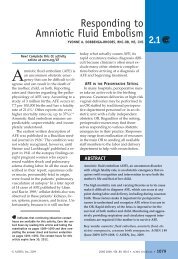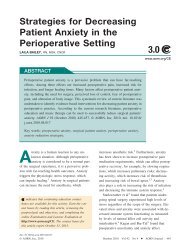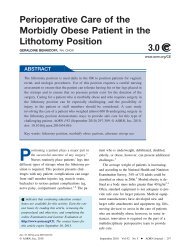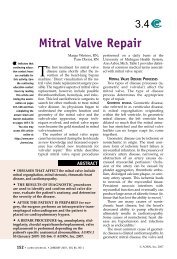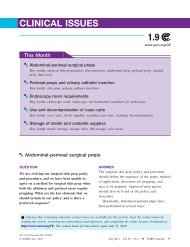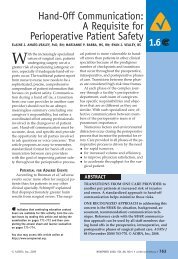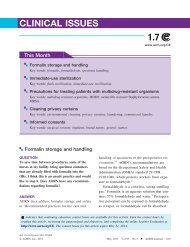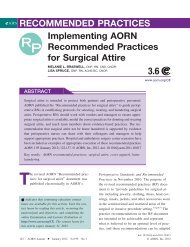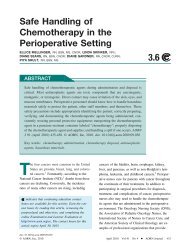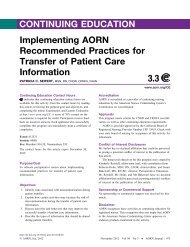The Ladd's Procedure for Correction of Intestinal Malrotation ... - AORN
The Ladd's Procedure for Correction of Intestinal Malrotation ... - AORN
The Ladd's Procedure for Correction of Intestinal Malrotation ... - AORN
Create successful ePaper yourself
Turn your PDF publications into a flip-book with our unique Google optimized e-Paper software.
Ingoe — Lange FEBRUARY 2007, VOL 85, NO 2<br />
least suspicious <strong>for</strong> intestinal malrotation.<br />
A volvulus may be seen as a thin<br />
line <strong>of</strong> contrast in a portion <strong>of</strong> intestine<br />
that is abnormally positioned. Either<br />
finding should generate an immediate<br />
referral to a pediatric surgeon.<br />
Plain x-rays, ultrasounds, and CT<br />
scans are not as reliable as a UGI series<br />
because the UGI uses contrast media<br />
that lights up on the scan. <strong>The</strong> contrast<br />
either stops flowing or only moves<br />
through a thin opening. A contrast BE<br />
may be per<strong>for</strong>med <strong>for</strong> evaluation <strong>of</strong><br />
cecal position if the cause <strong>of</strong> the obstruction<br />
still cannot be determined<br />
after a UGI series is per<strong>for</strong>med. 4 A BE is<br />
more reliable than x-rays, ultrasounds,<br />
and CT scans but is not as reliable as a<br />
UGI series because the barium only<br />
flows up a certain distance, whereas the<br />
contrast in a UGI follows the intestines<br />
all the way down. <strong>The</strong> area above the<br />
obstruction would not be visualized<br />
during a BE.<br />
PREOPERATIVE PREPARATION<br />
When the OR is being prepared <strong>for</strong> a<br />
pediatric procedure, the circulating nurse<br />
turns up the room temperature to between<br />
75° F and 85º F (23.9º C and 46º C)<br />
depending on the surgeon’s preference.<br />
<strong>The</strong> circulating nurse places a pediatric,<br />
underbody, <strong>for</strong>ced-air, temperatureregulating<br />
blanket on the bed 8 and obtains<br />
an IV-solution warmer and irrigation<br />
fluid warmer. <strong>The</strong> circulating nurse<br />
ensures that the pediatric emergency<br />
anesthesia cart is in the room.<br />
PREOPERATIVE CARE OF THE PATIENT. After the<br />
infant has been admitted to the preoperative<br />
holding unit, the circulating nurse<br />
greets the patient and his or her parents<br />
and confirms the patient’s identity using<br />
at least two identifiers (eg, the identification<br />
band, medical record, parent’s confirmation).<br />
After reviewing the patient’s<br />
medical record, the nurse ensures that<br />
the patient’s laboratory, radiology, and<br />
gastrointestinal test results are on the<br />
chart and verifies that the surgical consent<br />
is accurate according to the patient’s<br />
records, OR schedule, and parents. <strong>The</strong><br />
nurse verifies the patient’s allergies and<br />
NPO status with the parents and medical<br />
record. <strong>The</strong> nurse then per<strong>for</strong>ms an<br />
assessment that includes the patient’s<br />
vital signs, nutritional status, skin turgor,<br />
and skin pallor. <strong>The</strong> nurse then develops<br />
a care plan specific <strong>for</strong> this patient undergoing<br />
the Ladd’s procedure<br />
(Table 1).<br />
CARING FOR THE PARENTS BE-<br />
FORE SURGERY. This surgery<br />
usually is per<strong>for</strong>med on an<br />
emergency basis, so the infant’s<br />
parents may be emotionally<br />
distraught. <strong>The</strong><br />
circulating nurse can take<br />
numerous actions to help<br />
alleviate some <strong>of</strong> the parents’<br />
fear. If possible, the<br />
circulating nurse should<br />
sit down with the parents<br />
and introduce himself or<br />
herself. <strong>The</strong> nurse should<br />
explain exactly what the<br />
role <strong>of</strong> the circulating<br />
nurse is in taking care <strong>of</strong><br />
their child and explain the<br />
role <strong>of</strong> each perioperative<br />
team member, including<br />
ancillary personnel.<br />
<strong>The</strong> nurse should speak<br />
in a s<strong>of</strong>t, calm, and reassuring<br />
tone and should not<br />
speak rapidly. He or she<br />
should give the parents<br />
time to ask questions and<br />
to contemplate what he or<br />
she is telling them. To instill trust, the<br />
nurse should make eye contact with<br />
each parent and use touch when appropriate.<br />
<strong>The</strong> nurse should ensure that all<br />
<strong>of</strong> the parents’ questions have been answered<br />
and that they understand the procedure<br />
completely. <strong>The</strong> nurse should reassure<br />
the parents that he or she will call<br />
the waiting room periodically to give<br />
<strong>The</strong> circulating<br />
nurse can take<br />
numerous actions<br />
to help alleviate<br />
the parents’ fear,<br />
such as speaking<br />
in a reassuring<br />
voice and<br />
explaining the<br />
role <strong>of</strong> the<br />
circulating nurse<br />
in taking care <strong>of</strong><br />
their child.<br />
<strong>AORN</strong> JOURNAL • 303



